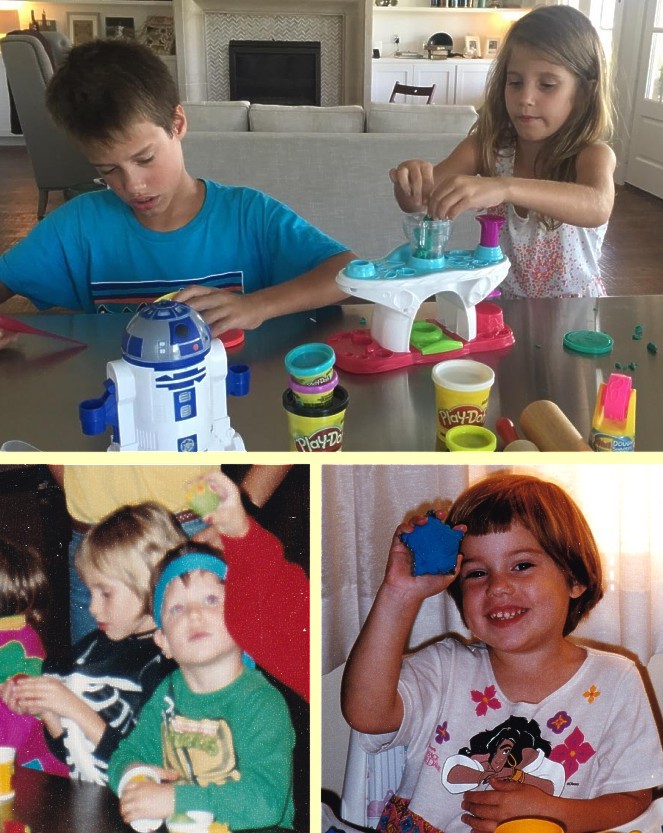Kansas Snapshots by Gloria Freeland - September 16, 2016
From problem to child's play
I always enjoy stories about products that were intended for one purpose, but then became big hits in an unrelated area.
I wrote a column about the man at 3M who was looking for a stronger adhesive and instead came up with a poor one that
ultimately led to Post-it notes. Then there was the Pfizer heart medication that was a flop during trials, but
a big hit as Viagra.
In most cases, additional important elements of these stories include a bit of serendipity and someone imagining the
product in a completely different setting. Business people sometimes describe this as seeing a problem as an opportunity.
The following story certainly has all these elements.
In the 1940s, the Ohio-based Kutol comapny had been manufacturing for the Kroger company a special putty-like soap for
cleaning wallpaper. Then, near the end of the decade, vinyl wallpaper came in and coal-fired heating systems with their
soot-producing furnaces went out. People needed to clean their wallpaper less and could do it with ordinary soap and water.
I stumbled on this story by accident when I was thumbing through my latest issue of "Real Simple" magazine. Each month,
they publish fun facts about all sorts of random topics, and one of them this month was Kutol's problem. It caught my
attention because the product they came up with and I are both celebrating special events this week.
According to the National Toy Hall of Fame and Wikipedia, Kutol's chief Noah McVicker brought his nephew Joe McVicker
into the company to solve their problem. Joe's sister-in-law was a nursery school teacher who was using the wallpaper
cleaner as a modeling clay. She had found that regular modeling clay was too hard for her children to work with. So Joe
removed the detergent, added color and fragrance, and marketed the product as clay for children.
When he took the modeling clay to a national education convention in 1955, word spread quickly to Macy's and Marshall
Field's. A year later, Play-Doh was born. Since then, more than three billion cans of the bright, lightweight clay have been
sold.
In 1998, the National Toy Hall of Fame inducted Play-Doh. In 2006, September 16 - today - was selected as National
Play-Doh Day!
I asked sister Gaila what she remembered about Play-Doh. She said she recalled the smell and that it came in four or five
colors. She also recalled another odd trait of the stuff that I always thought was rather cool.
"I remember that if you smooshed it on cartoons or (newspaper) writing, the print would come off on the Play-Doh," she
told me.
I asked husband Art too, but he just responded, "It was after my time."
But not so for our girls. Mariya said she enjoyed "making a combination of monstrous sculptures and layered cakes." Katie
remembers making cookies and pies with it, but she said she didn't like it when the colors mixed together and the way it
felt on her hands. She has always had an aversion to having anything sticky on them.
My nephew Paul's wife Rachel said their three children love to play with it.
I have a picture of Sydney as a little girl. She used to just make balls of all the colors and then line them up during
her "lining things up" phase ... Erynn says it tastes like it smells. Salty. I remember making peanut butter Play-Doh when I
was little so we could eat it and not get sick.
In the 1980s, Play-Doh increased the number of colors available from five to eight. Later versions came with glitter,
glowed in the dark or smelled like shaving cream. The company expanded its product line to include the Fun Factory, which
allows kids to squeeze out the material into interesting shapes, such as stringy hair, colorful spaghetti and pretend ice
cream that won't melt.
The Hasbro company, which bought the rights to the product years ago, not only markets the modeling clay, but all sorts of
play sets to go with it. Some examples are Play-Doh Doctor Drill 'n' Fill, Play-Doh Disney Princess Ariel Undersea Castle,
Play-Doh Stamp and Roll Set featuring Despicable Me Minions and Play-Doh Star Wars Millenium Falcon featuring Can-Heads. Paul
and Rachel's son Chase has a Star Wars R-2 D-2 Play-Doh toy.
I asked Rachel if she ever made the homemade kind.
"I've tried ... it never worked," she said. "Too slimy!"
My sister-in-law Linda makes her own version for her preschool. She uses different colors for different seasons, such as
orange during October for autumn and Halloween crafts and green in December for Christmas items. She says if she keeps it in
airtight containers, it will last up to three months. She shares her recipe with parents and grandparents of the children
she teaches.
My birthday was Tuesday, so if Sept. 16, 2006 is used as Play-Doh's official beginning, it would be only 10 years old ...
and would be MUCH younger than I am. If I used 1956 when the product hit its marketing stride, this year would be number 60
for the kids' clay. That's in my range, but I'm still a bit older.
I think I'll consider 1947 as its birthday. Then, next Sept. 16, it will be 70 and I will be just a kid by comparison. Oh,
and Kutol - they are still in the cleaning business, specializing in hand sanitizing products.
